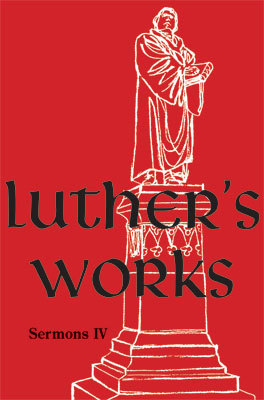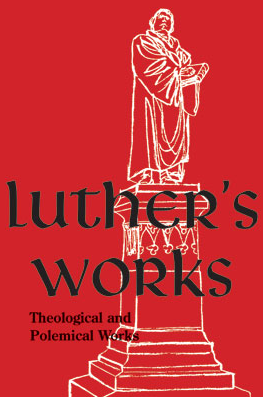


Books in series

Lectures on Genesis
Chapters 1-5
1752

Lectures on Genesis
1960

Lectures on Genesis
Chapters 15-20
1961

Lectures on Genesis
Chapters 21-25
1964

Lectures on Genesis
Chapters 31-37
1969

Lectures on Genesis
Chapters 38-44
1964

Lectures on Deuteronomy
1960

Lectures on the Psalms II
Chapters 76-126
1976

Selected Psalms I
1968

Selected Psalms II
1956

Selected Psalms III
1958

Ecclesiastes, Song of Solomon, and the Last Words of David
1971

Lectures on Isaiah
Chapters 40-66
1971

Lectures on the Minor Prophets III
1973

Luther's Works, Volume 22
1957

Lectures on Romans, Glosses and Schoilia
1972

Lectures on Galatians
Chapters 1-4
1535

Luther's Works Lectures on Galatians/Chapters 5-6 Chapters 1-6
1964

Commentaries on 1 Corinthians 7, 1 Corinthians 15, Lectures on 1 Timothy (Luther's Works, Vol. 28) (Luther's Works
1973

Lectures on Titus, Philemon, Hebrews
1968

Luther's Works, Volume 31
Career of the Reformer I
1957

Luther's Works, Volume 32
Career of the Reformer II
1958

Luther's Works
Career of the Reformer III
1957

Luther's Works vol. 34, Career of the Reformer IV
1536

Luther's Works, Volume 35
Word and Sacrament I
1960

Luther's Works, Vol. 36
Word and Sacrament II
1959

Luther's Works, Volume 37
1976

Luther's Works
Church and Ministry I
1970

Luther's Works, Volume 42
Devotional Writings I
1969

The Christian in Society, Vol. I
1966

The Christian in Society, Vol. II
1962

Letters, Vol. II
1972

Luther's Works
Sermons II
1974

The Table Talk of Martin Luther
1967

Sermons IV
2016

Theological and Polemical Works
2021

Vogel's Cross Reference to Luther's Works
1983

Vogel's Cross Reference and Index to the Contents of Luther's Works
A Cross Reference Between the American Edition and the St. Louis, Weimar, and
1983
Authors

Martin Luther (1483-1546) was a German monk, theologian, university professor and church reformer whose ideas inspired the Protestant Reformation and changed the course of Western civilization. Luther's theology challenged the authority of the papacy by holding that the Bible is the only infallible source of religious authority and that all baptized Christians under Jesus are a spiritual priesthood. According to Luther, salvation was a free gift of God, received only by true repentance and faith in Jesus as the Messiah, a faith given by God and unmediated by the church. Luther's confrontation with Charles V at the Diet of Worms over freedom of conscience in 1521 and his refusal to submit to the authority of the Emperor resulted in his being declared an outlaw of the state as he had been excommunicated from the Roman Catholic Church. Because of the perceived unity of the medieval Church with the secular rulers of western Europe, the widespread acceptance of Luther's doctrines and popular vindication of his thinking on individual liberties were both phenomenal and unprecedented. His translation of the Bible into the vernacular, making it more accessible to ordinary people, had a tremendous political impact on the church and on German culture. It furthered the development of a standard version of the German language, added several principles to the art of translation, and influenced the translation of the English King James Bible. His hymns inspired the development of congregational singing within Christianity. His marriage to Katharina von Bora set a model for the practice of clerical marriage within Protestantism. Much scholarly debate has concentrated on Luther's writings about the Jews. His statements that Jews' homes should be destroyed, their synagogues burned, money confiscated and liberty curtailed were revived and used in propaganda by the Nazis in 1933–45. As a result of this and his revolutionary theological views, his legacy remains controversial.
